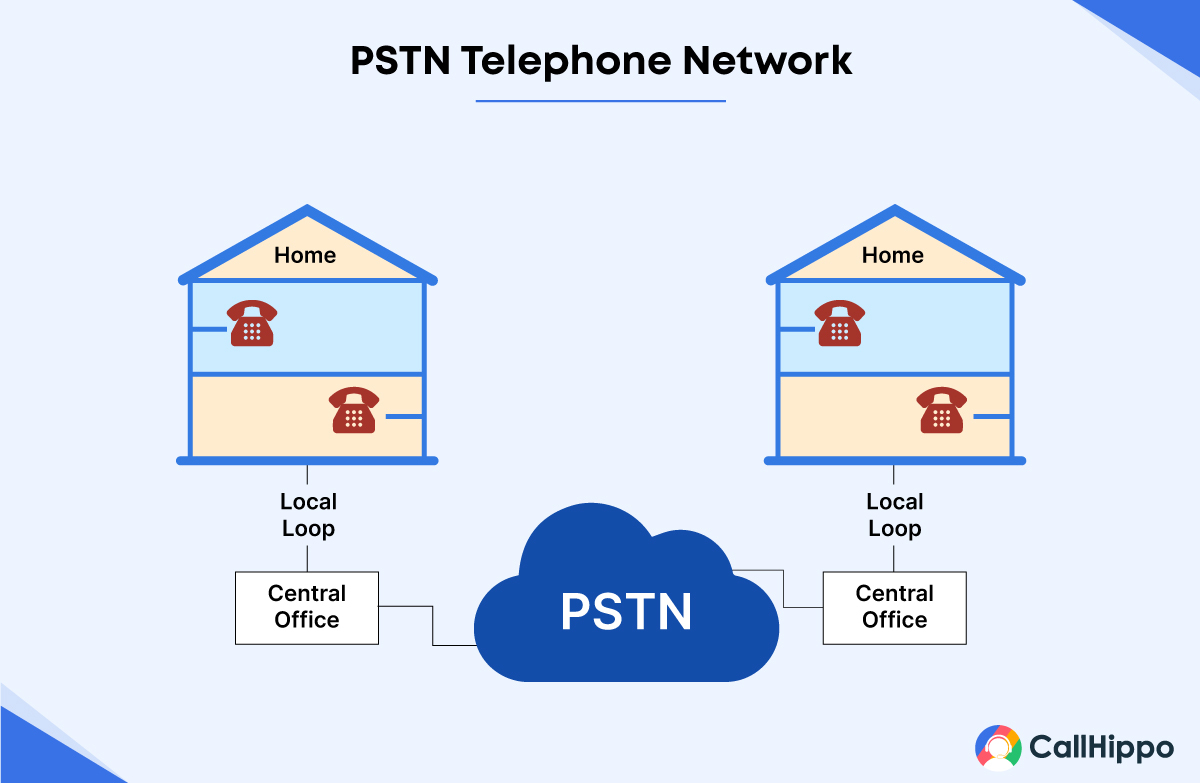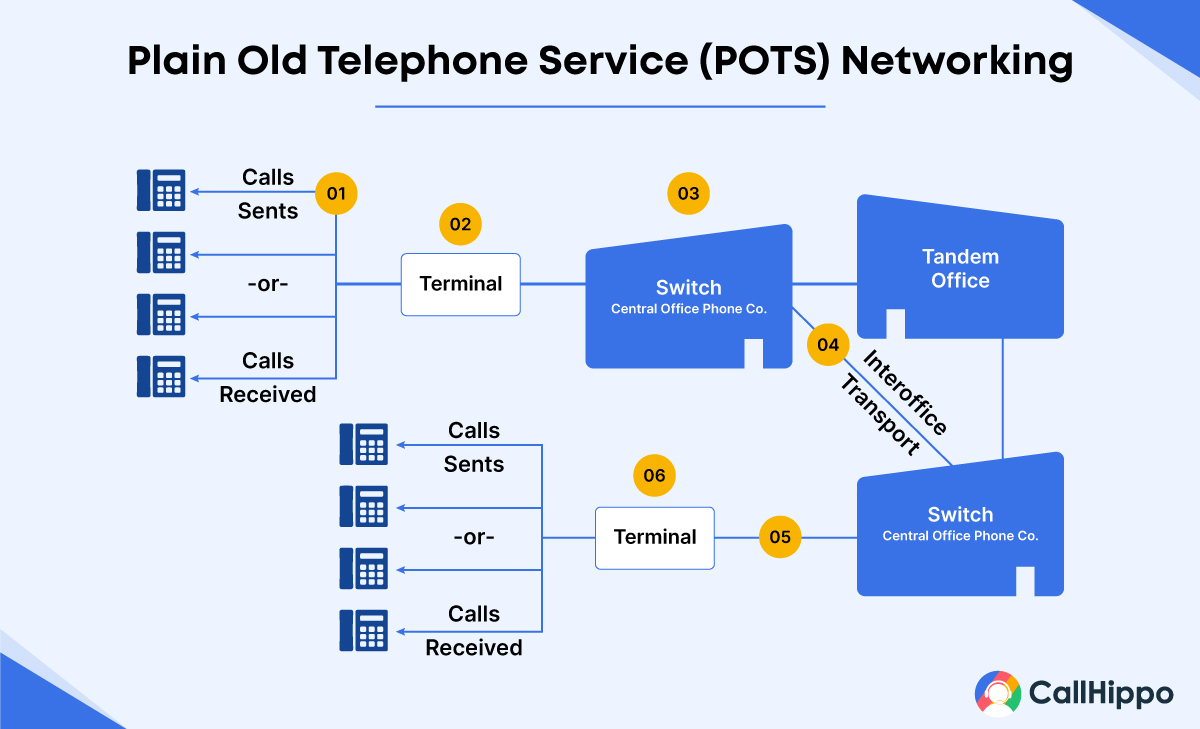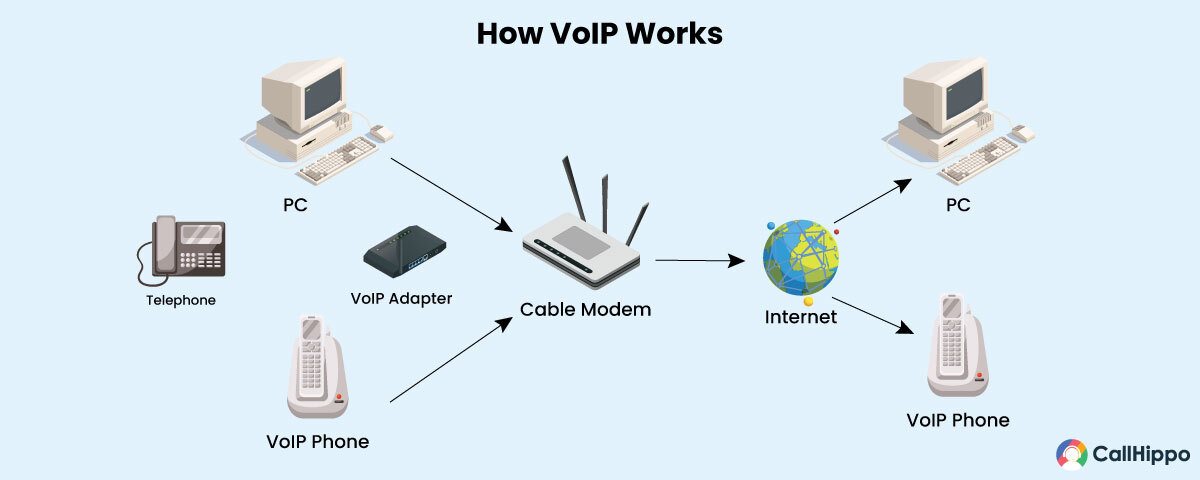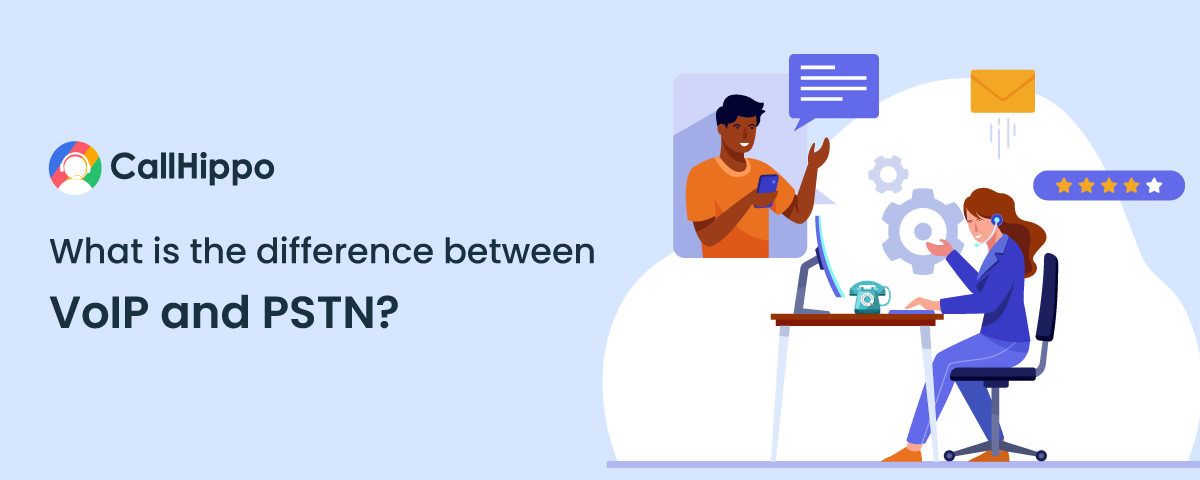Do You Want to Make More Calls?
Set up CallHippo VoIP system in less than 3 minutes and start calling.
Senior Writer: Priya Naha
How do we make phone calls? Numerous technologies connect people and businesses. But a basic telephone call connection isn’t as easy as it seems. It depends on a complicated system, requiring multiple technologies to route calls. The most prominent technologies are Public Switched Telephone Networks (PSTN) and Voice over Internet Protocol (VoIP). And the debate between PSTN vs. VoIP phone services is never-ending.
So, how do we know which is better?
This article will look at both technologies, explore the difference between VoIP and PSTN, and help you decide which phone network is better for your company.
What Is PSTN?
A PSTN, or Public Switched Telephone Network, is called a POTS or Plain Old Telephone Service. It is a fancy catchphrase for classical telephony, in which phones are linked to dedicated networks. These networks enable you to reach another person regardless of the network as long as you know the right number for them to call.
To make calls, landline phones rely on this wired connection to carry analog voice data.

Completing a circuit refers to establishing a call between two telephones. A telephone call passes through numerous local, national, or international switches to complete a circuit using a mechanism known as circuit switching.
Copper wiring was used initially to link two phones together to form a call. Operators sat near switchboards, connecting a pair of copper wires to send calls from one location to another.
Manual switching has given way to automated switching, and copper lines have been replaced with fiber-optic cables.
How Do PSTN Telephone Lines Work?
Consider Public Switched Telephone Network (PSTN), a worldwide network of telephone lines, fiber optic cables, switching centers, cellular networks, satellites, and cable systems. These allow telephones to communicate with one another.

When you dial a phone number, your call travels via the network to its destination – the two devices have been connected. Consider what comes about when you dial a number from your cell phone to comprehend how a PSTN works fully.
Step 1 – Your phone’s receiver turns sound waves into electric signals. The signals are then sent via cable to a terminal.
Step 2 – The terminal collects and transmits electrical signals to the central office (CO).
Step 3 – The central office transmits the calls as electrical signals via fiber optic cable. The fiber optic channel transports these signals as light pulses to their destination.
Step 4 – Your call is sent to a tandem office (a regional hub in charge of transferring calls to remote central offices) or a central office (for regional calls).
Step 5 – Once your call reaches the appropriate office, it is returned to an electrical signal and sent to a terminal.
Step 6 – The call is routed via the terminal to the right phone number. When a call is received, the telephone line transforms electrical signals to sound vibrations.
This may appear confusing, but remember that your call only takes a few seconds to reach its destination. Fiber optic connections and a worldwide network of switching centers aid this process.
What Is VoIP?
VoIP stands for Voice over Internet Protocol. It allows customers to make and receive phone calls online rather than via traditional landlines. VoIP phone system uses packet-switching technology to transfer voice signals from one address to another.
VoIP calls are placed using devices that are directly linked to the internet. These gadgets may resemble standard office phones, cellular phones, or computer applications.

Voice over IP is a technology that turns your voice into an electronic signal, encrypts it and sends it across the internet. The call is set up between all participants by a VoIP service provider. The digital information is then decompressed at the receiving end into the sound you hear via your smartphone or speakerphone.
How Do VoIP Calls Work?
A VoIP phone system is a technique that allows you to make phone calls using your internet connection rather than a traditional landline or mobile network. Over your broadband connection, a VoIP system turns analog speech impulses into digital signals. A VoIP server is used to link phone calls to other networks.

You can use a VoIP service with a high-speed internet connection, router, and modem.
A basic VoIP setup includes a desk telephone and a SIP server that works much better than a typical landline phone because it has far more functionality than analog phone service could give.
How VoIP Helps Your Business?
Many organizations use VoIP, digital voice communications, and other communication applications hosted in the cloud to make their employees more adaptable.
However, VoIP provides far more than enhanced flexibility to businesses. It offers significant advantages that can improve the consumer experience and promote growth. Owing to the immense help it offers, the VoIP market size has surpassed $43.92B in 2023 and will grow at a CAGR of 9.8% from 2023 to 2033.
Let’s look at how VoIP helps businesses.
1. Reduced Phone Costs
VoIP transmits voice data over the internet rather than phone lines. Owing to this, your business will see decreased operating and calling costs. When businesses transition to VoIP, their phone bill prices drop, and they can save on operational costs. You don’t have to maintain distinct networks for data and phones, which allows you to reduce costs.
Your company can save costly landline setup expenses as you don’t need to pay for a PBX (Private Branch Exchange) system, hubs, switches, telephone adaptors, or other gear.
You can save money on local and international calls using a virtual number rather than one linked to a physical landline phone.
2. Improved Security
With VoIP, your company can access additional call functionalities and security measures in its arsenal. Landline and internet-based calls have flaws, but a correctly set up VoIP phone system can help you develop a more secure one.
To improve security, your company can employ the following VoIP tools:
- End-to-end encryption
- Endpoint protection
- Call apps with two-factor authentication
- Call blocking and labeling for spam
Select a hosted phone system supplier that adheres to the extremely high data center, network, and product protection requirements to ensure top-tier security.
3. Work From Anywhere
Work flexibility is another game-changing effect of VoIP. Modernizing your phone system with online calling lets your employees work from anywhere. It implies that your company can go completely remote or use a hybrid approach.
When your phone system is hosted in the cloud, the work-from-home option makes your business more flexible. If individuals can’t be in the office, whether it’s because they’re traveling, prefer working from home, or an emergency won’t let them, operations can continue as usual.
4. Advanced Call Features
One of the most significant advantages of VoIP for businesses is its functionality. VoIP and cloud-based communications technologies have evolved significantly in recent years, so you can discover a provider that offers a comprehensive collection of essential capabilities when comparing platforms.
Call forwarding, Interactive Voice Response (IVR), call recording, analytics, auto attendant, call queuing, and connectivity with your other corporate applications are all standard features of a modern VoIP solution. These solutions can help you better serve your customers by improving call flows and offering performance insights.
A landline business system necessitates the purchase of a high-priced PBX system as well as the payment of add-ons for additional functionality.
5. Improved Call Quality
Customers and staff will enjoy superb call quality if your company has a good internet connection and enough capacity. With VoIP, your company can also have more control over call quality because you can utilize a headset or microphone and alter the settings to get the sound you want.
A strong connection with adequate bandwidth is essential for high-quality VoIP calls. Without this, it can be a nightmare, especially if your workplace frequently makes concurrent calls. Imagine someone who always phones in on their cell phone, and everyone else suffers from echoes, delays, and background noise!
VoIP phones eliminate distractions, allowing you to concentrate on the meeting’s agenda. VoIP phones gain greater sound quality through innovations such as noise-canceling microphones and advanced audio compression.
PSTN vs. VoIP
Let’s see which technology is more reliable and secure in the PSTN vs. VoIP debate. PSTN improves business continuity as there is no loss in connection after a power outage. When VoIP technology was evolving, dropped calls and poor call quality were common due to jitter and delay. But today, the quality and dependability of VoIP services have improved.
Unlike PSTN services, emergency location services are frequently challenging for VoIP providers. However, in the debate between PSTN vs. VoIP, VoIP offers some advantages, such as lower network infrastructure costs, scalability, and sophisticated capabilities like unified communications and app integrations.
The table below will help you determine the difference between VoIP and PSTN if you are still confused.
| Difference Type | PSTN | VoIP | |
| Technology | PSTN uses traditional analog technology that relies on a physical network to transmit voice signals. | VoIP uses digital technology to transmit voice and data over the internet. It allows for greater flexibility, scalability, and advanced features like video conferencing and virtual phone numbers. | |
| Call Quality | PSTN call quality remains consistently stable, with little to no interference or dropped calls due to the use of dedicated voice circuits. |
| |
| Equipment Needed | PSTN requires a landline phone and a physical network connection, which a local telephone company typically provides. This limits mobility and remote work capabilities. | VoIP requires a high-speed internet connection and a device, such as a computer, smartphone, or VoIP phone. This allows for greater mobility and remote work capabilities. | |
| Cost | PSTN is typically more expensive, especially for long-distance calls. | VoIP is less expensive, especially for long-distance and international calls. VoIP uses the internet to transmit voice data and is typically cheaper than dedicated voice circuits. | |
| Mobility | PSTN is typically limited to fixed locations and less flexible for mobile workers or remote teams. | VoIP is highly mobile and can be used anywhere with an internet connection. It is easy to use on mobile devices and allows remote work and collaboration. | |
| Accessibility | PSTN is limited to areas with physical networks. infrastructure and it may not be available in some rural or remote areas. | VoIP is available globally as long as there is a reliable internet connection. | |
| Features | PSTN offers limited customization and features. It requires additional equipment for advanced functionality. | VoIP offers multiple features and customizations, like video conferencing, virtual phone numbers, and advanced call routing. | |
| Reliability | PSTN is less dependent on internet connectivity and is generally more reliable regarding call quality and connectivity. | VoIP reliability depends on the quality and reliability of the internet connection and may be affected by network congestion or disruptions. | |
| Maintenance | PSTN requires more maintenance. The physical network infrastructure may need repairs or upgrades over time. | VoIP requires low maintenance, as the service provider can perform most upgrades and maintenance tasks remotely. | |
| Emergency Calling | PSTN is reliable for emergency calls and is often the preferred method for emergency service. | VoIP supports emergency calls. But, the reliability and accuracy may vary by location and network quality. | |
| Security | PSTN calls are more difficult to intercept but may still be vulnerable to wiretapping. | VoIP calls can be vulnerable to hacking or interception if improperly secured. | |
| Scalability | PSTN requires physical infrastructure upgrades or additions to scale up. | VoIP can be easily scaled up or down based on business needs without additional physical infrastructure. | |
| Integration | PSTN integration with other tools is more limited. | VoIP can be integrated with other business tools like customer relationship management (CRM) systems to streamline workflows and improve efficiency. | |
| User Interface | The interface is limited to basic call features, such as making and receiving calls, call waiting, and call forwarding. PSTN users cannot access advanced features such as video conferencing and call recording without additional equipment or services. | The user interface is a software-based application accessed through a computer, smartphone, or other device. It may include a dial pad, call logs, and other features like video conferencing, call recording, and screen sharing. Users can access these features through a web-based portal, desktop, or mobile application. | |
| Environment-Friendly | PSTN requires significant physical infrastructure and energy. | VoIP is a greener technology than PSTN, as it does not require as much physical infrastructure and uses less energy. |
Feature Comparison: PSTN Vs. VoIP
It’s an easy decision when you compare the features of VoIP and PSTN side by side. VoIP systems always win. Because of its unrivaled flexibility, your company communications will operate more efficiently than ever. Your team will reap the benefits of remote work without the logistical nightmare of a desk phone.
You can take a look at the table below.
| Feature | PSTN | VoIP |
| Call Quality | ? | ? |
| Wireless Capacity | ? | ? |
| Call Forwarding | ? | ? |
| Caller ID | ? | ? |
| SMS and MMS | ? | ? |
| Video Calls | ? | ? |
| Integration | ? | ? |
| Virtual Numbers | ? | ? |
| Screen Sharing | ? | ? |
| API Access | ? | ? |
| Interactive Voice Response | ? | ? |
| Call Waiting | ? | ? |
| Multiple Lines | ? | ? |
| On-Hold Music | ? | ? |
Cost Of PSTN vs. VoIP
A PSTN system can provide basic business call capabilities like voicemail and caller ID. Still, you need to pay extra for each function. It implies that if you add additional hardware and calling options to your business, your expenses may skyrocket. The average PSTN costs $30-$100 for a new desk set. You need an extra $150-$300 for installation.
However, VoIP service is economical and scalable, and basic call functions are typically included in base subscription plans.
Companies that move to a virtual phone system generally save on telephone expenditures. The VoIP phone bill is comparatively less as it uses the Internet to link users across its cloud-based infrastructure, so calls are not priced based on time or distance. Instead, consumers are charged on a subscription basis, which varies depending on the services chosen and the number of people who will be connected.
The average VoIP phone system ranges from $99 to $400 per extension. Maintenance, service fees, and other ongoing charges typically range between $20 and $30 per monthly extension.
Switch From PSTN To VoIP
Many businesses have transitioned from PSTN to VoIP, and numerous interesting case studies are available online.
Qt, a global software company, is an intriguing example.
Communication was critical to the company’s success, with a strong community of clients worldwide. Qt wanted to expand its business in Australia without incurring time and cost.
In the past, the company had issues setting up business in Australia. Qt’s main aim was to create a local presence for the brand and create a connection with the Australian audience.
This is when the company moved away from a traditional phone and sought a reliable VoIP phone system provider.
CallHippo helped Qt bridge the gap, establish a local presence in Australia and stay connected to the headquarters. Connecting with international customers became seamless using numerous features like click-to-call, global connect, and dashboard analytics.
Qt was so impressed with CallHippo that the company integrated it into its CRM, which helped them save a lot of time.
Set Up Your VoIP With CallHippo
CallHippo is a cloud-based business phone system that provides Voice over Internet Protocol (VoIP) services to businesses of all sizes. CallHippo allows businesses to make and receive calls from anywhere worldwide using an internet connection.

Founded in 2016, CallHippo has quickly become popular for businesses seeking to streamline communication and collaboration.
You can consider setting up your VoIP with CallHippo for various reasons:
1. Cost-Effective
CallHippo offers affordable pricing plans for its VoIP services. It helps you save money on your communication expenses. You can choose from various plans depending on your business needs and budget.
2. Easy To Use
CallHippo’s VoIP system is easy to use. There’s no requirement for technical expertise to get started. The system’s intuitive interface makes managing calls, contacts, and settings easy.
3. Scalability
CallHippo’s VoIP system is scalable. Companies can easily add or remove users as the business grows or changes. You can also customize your VoIP features according to your business needs.
4. Reliability
CallHippo’s VoIP system is reliable, with a 99.95% uptime guarantee. It ensures companies can stay connected with their customers and colleagues without interruptions.
5. Mobility
CallHippo’s VoIP system can access your calls and contacts from anywhere using your smartphone or tablet. This can help you stay connected even while you are traveling.
6. Advanced Features
CallHippo’s VoIP system offers a range of advanced features that can help you manage your communication more efficiently. Some features include call forwarding, call recording, voicemail, and interactive voice response (IVR).
- Call Forwarding: Call forwarding is a feature that allows businesses to redirect incoming calls to another phone number or extension. CallHippo’s call forwarding feature ensures the agent can answer all calls, even if the primary phone line is busy or unavailable.
- Call Recording: Call recording allows businesses to record and store incoming and outgoing calls. It is useful for quality control, training, or legal compliance. The call recording feature in CallHippo is easy to use, and companies can access their call recordings anytime.
- Voicemail: Voicemail allows callers to leave a message when the recipient is unavailable or doesn’t answer the phone. You can customize the voicemail feature in CallHippo. It allows businesses to easily create personalized greetings and manage voicemail messages.
- Interactive Voice Response (IVR): IVR helps businesses create automated menus that guide callers to the right department or person. The IVR feature in CallHippo is really helpful. You can create tailored menus and set up call routing rules to ensure calls are directed to the right person or department.
7. Integration
CallHippo’s VoIP system can integrate with various popular business tools and applications, including customer relationship management (CRM) software, helpdesk software, and productivity apps. It allows businesses to streamline their communication and collaborate more effectively.
Conclusion
PSTN and VoIP are like two ends of the same line. One could consider VoIP to be an improvement of PSTN. PSTN technology evokes nostalgia, but the truth is that it is old and has lost user count over time. It will most likely vanish in the distant future. However, its importance to the advancement of communication cannot be overlooked. It is correct to argue that PSTN started a revolution, and VoIP aims to continue it in the twenty-first century and beyond.
Switching from PSTN to VoIP is the best option if you want to develop your business and deliver a better customer experience while cutting costs. VoIP provides your organization with all the communication tools it needs to flourish, from auto-attendants to call forwarding and powerful call center analytics.
RELATED ARTICLES:
Frequently Asked Questions
What are the three major components of PSTN?
You can understand Public Switched Telephone Networks (PSTN) ‘s three major components:
- Access
- Switching
- Transport
Are VoIP calls secure?
VoIP is a secure way to communicate with clients and customers, as the network is constantly protected and monitored. CallHippo is one of the leading VoIP providers that ensure effective security at affordable prices.
Do VoIP users need a phone handset?
It is optional for VoIP users to have a phone headset. There are alternative solutions to using phone handsets. You can make calls through certain mobile apps or via a desktop with a microphone/speaker combination or headset attached.
Which signaling is used in PSTN?
The common channel signaling system 7 (SS7) controls PSTN signaling, including call setup, management, and teardown. The standards allow for numerous versions, which are used worldwide.
How does VoIP integrate with PSTN?
When you integrate a VoIP call to a PSTN line, the method is the same as when you make a VoIP call. Digital data packets are created from your analog voice. These packets use the internet as a conduit to reach your VoIP provider and their carriers.

Subscribe to our newsletter & never miss our latest news and promotions.
 +21K people have already subscribed
+21K people have already subscribed




